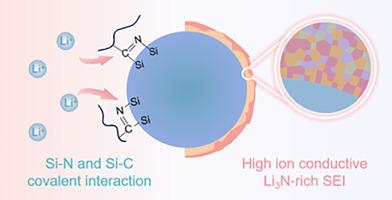Formation of a robust SEI through covalent binding nitrile to silicon toward stabilized micron-sized silicon anodes
IF 8.9
2区 工程技术
Q1 ENERGY & FUELS
引用次数: 0
Abstract
Constructing robust solid electrolyte interface (SEI) has long been regarded as an effective strategy for stabilizing silicon anodes and still remains a great challenge. In this work, we experimentally demonstrate that the covalent binding of polyacrylonitrile (PAN) binder to silicon results in the formation of robust bilayer SEI containing a Li3N-rich inner layer and an organic-components-rich outer layer. The in situ generated N-rich SEI is mechanically stable and ion-conductive. As a result, the stability and adhesion of silicon electrodes are greatly enhanced. Specifically, silicon electrodes utilizing PAN binder exhibit remarkable improvements in terms of Coulombic efficiency (CE), rate performance, and cycling stability (1290 mAh g−1 after over 800 cycles at 0.5 C) compared to the electrodes utilizing other binders. The silicon surface functionalization strategy offers a potential approach paving the way toward the development of stable and high-energy silicon-based lithium-ion batteries.

通过丙烯腈与硅的共价结合形成稳定的微米级硅阳极
构建坚固的固体电解质界面(SEI)一直被认为是稳定硅阳极的有效策略,但仍然是一个巨大的挑战。在这项工作中,我们通过实验证明,聚丙烯腈(PAN)粘合剂与硅的共价结合导致形成坚固的双层SEI,其中包含富li3n的内层和富有机成分的外层。原位生成的富n SEI具有机械稳定性和离子导电性。从而大大提高了硅电极的稳定性和附着力。具体而言,与使用其他粘合剂的电极相比,使用PAN粘合剂的硅电极在库仑效率(CE),速率性能和循环稳定性(在0.5 C下循环800次后1290 mAh g−1)方面表现出显着的改善。硅表面功能化策略为开发稳定、高能量的硅基锂离子电池铺平了道路。
本文章由计算机程序翻译,如有差异,请以英文原文为准。
求助全文
约1分钟内获得全文
求助全文
来源期刊

Journal of energy storage
Energy-Renewable Energy, Sustainability and the Environment
CiteScore
11.80
自引率
24.50%
发文量
2262
审稿时长
69 days
期刊介绍:
Journal of energy storage focusses on all aspects of energy storage, in particular systems integration, electric grid integration, modelling and analysis, novel energy storage technologies, sizing and management strategies, business models for operation of storage systems and energy storage developments worldwide.
 求助内容:
求助内容: 应助结果提醒方式:
应助结果提醒方式:


